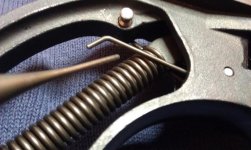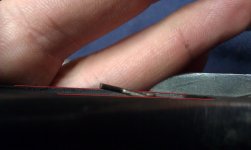FrankenMauser
New member
I am constantly seeing people bragging about the "trigger job" they just did on their Ruger single action revolvers, only to find out it is the stupid method made popular by Jeff Quinn's Gun Blast article.
I have always tried to tell people that this is not an appropriate method to lighten the trigger pull on these revolvers, but didn't have any hard evidence. Today, that changed.
After some much needed periodic maintenance, and a trigger job on my Super Blackhawk; I decided to give the "Poor Boy" a try for reliability. (This is the only revolver I own, that was 100% stock before today's trigger job. -It still has the factory springs.)
I was extremely surprised. It didn't do a damn thing for the trigger pull. And.... it took less than 3 pulls of the hammer, for a result. The hammer was stuck partially cocked. I absolutely could not cock the revolver, or let the hammer down.
In the first photo, you can see the unhooked trigger spring leg resting on the main spring. That, in itself, is something I don't like.
But... things were made much worse by the fact that the spring was being deflected, and contacting the grip panel. The main spring can shift on the hammer strut in Ruger revolvers. When that happens, it is capable of putting pressure on the trigger spring. ...just as it did here.
With the trigger spring wedged between the main spring and the grip panel, the hammer strut and main spring could not move. So, the hammer could not move.
Feel free to try the Poor Boy's trigger job. If you are lucky, everything will be fine. If you are not... you'll suffer an irritating, and potentially dangerous stoppage. (Grip panel must be removed, at a minimum. But the loading gate can't be opened without the hammer down. So, the revolver can't be rendered safe, in the mean time...)
If you are lucky, everything will be fine. If you are not... you'll suffer an irritating, and potentially dangerous stoppage. (Grip panel must be removed, at a minimum. But the loading gate can't be opened without the hammer down. So, the revolver can't be rendered safe, in the mean time...)


(Red lines added to distinguish the two surfaces of the grip frame.)
I have always tried to tell people that this is not an appropriate method to lighten the trigger pull on these revolvers, but didn't have any hard evidence. Today, that changed.
After some much needed periodic maintenance, and a trigger job on my Super Blackhawk; I decided to give the "Poor Boy" a try for reliability. (This is the only revolver I own, that was 100% stock before today's trigger job. -It still has the factory springs.)
I was extremely surprised. It didn't do a damn thing for the trigger pull. And.... it took less than 3 pulls of the hammer, for a result. The hammer was stuck partially cocked. I absolutely could not cock the revolver, or let the hammer down.
In the first photo, you can see the unhooked trigger spring leg resting on the main spring. That, in itself, is something I don't like.
But... things were made much worse by the fact that the spring was being deflected, and contacting the grip panel. The main spring can shift on the hammer strut in Ruger revolvers. When that happens, it is capable of putting pressure on the trigger spring. ...just as it did here.
With the trigger spring wedged between the main spring and the grip panel, the hammer strut and main spring could not move. So, the hammer could not move.
Feel free to try the Poor Boy's trigger job.
(Red lines added to distinguish the two surfaces of the grip frame.)


